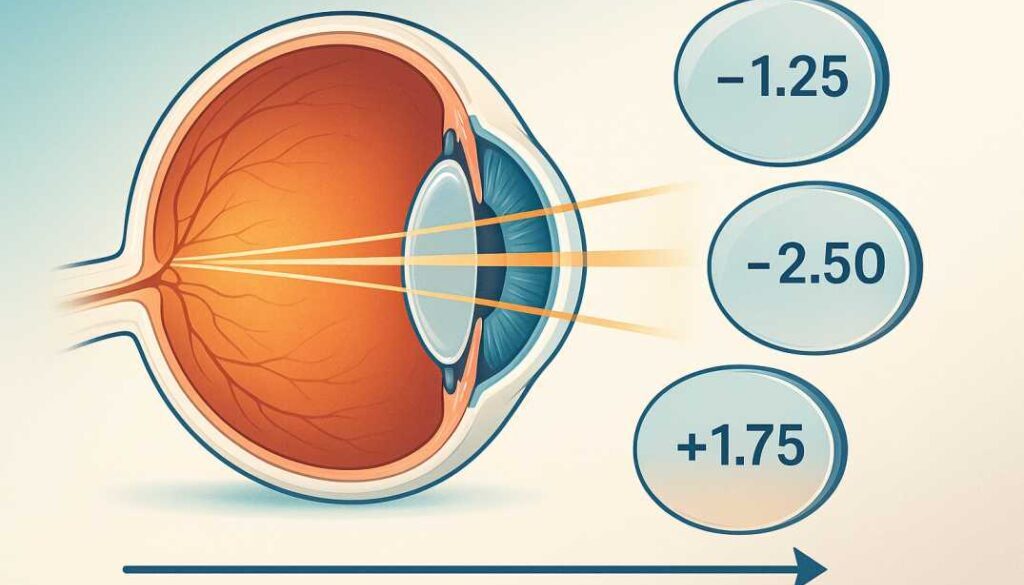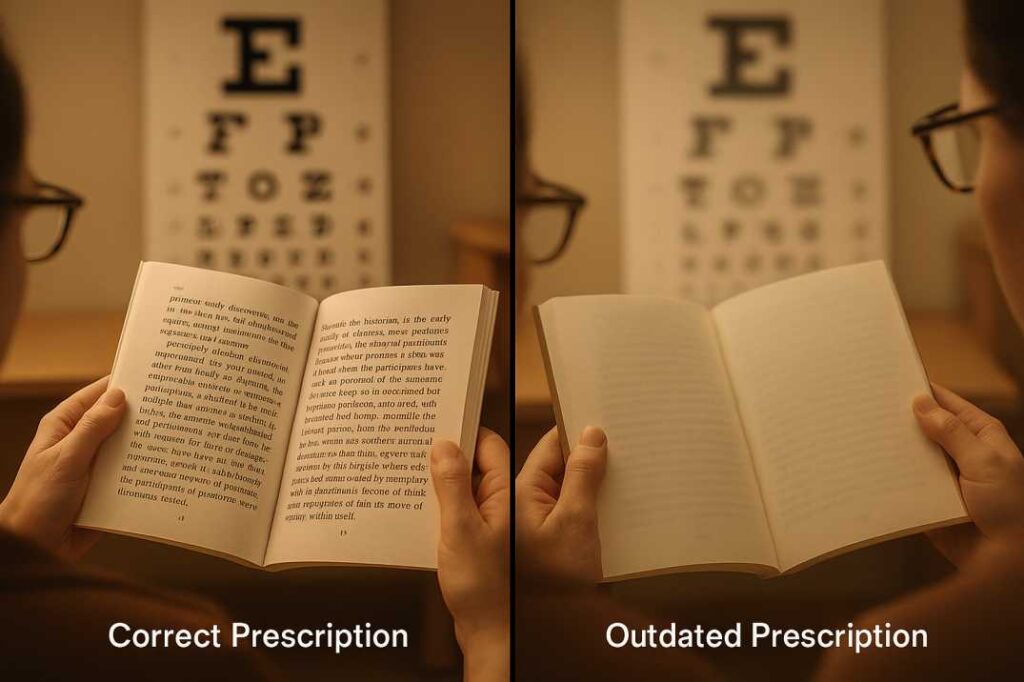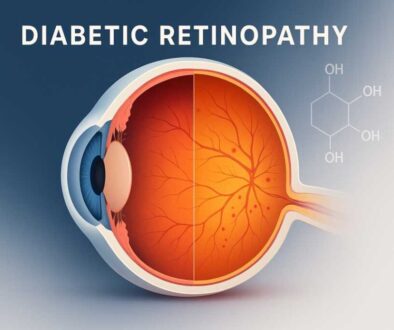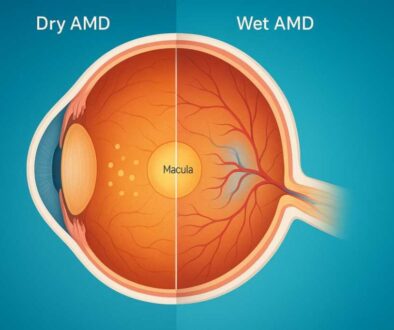Prescription Changes: Why Your Eyeglass Strength May Fluctuate Over Time
The Bottom Line: Your eyeglass prescription changes over time due to natural aging, eye growth, health conditions, and lifestyle factors. Understanding why prescription changes occur helps you maintain optimal vision and eye health throughout your life. Regular comprehensive eye exams with your trusted eye care provider are the key to detecting and managing prescription changes effectively.
Understanding Why Your Eyeglass Prescription Changes
If you’ve ever wondered, “Why does my eyeglass prescription keep changing?” you’re not alone. This is one of the most common concerns we hear from patients at West Broward Eyecare Associates. The truth is, your eyes are dynamic organs that naturally change throughout your lifetime, and your eyeglass strength needs to adapt accordingly.
Prescription changes are normal. From childhood development to adulthood, your vision evolves as part of your body’s natural progression. Understanding these prescription fluctuations empowers you to take proactive steps to maintain clear, comfortable vision.
What Makes Prescription Changes Happen?
Several factors cause prescription changes in your eyeglass strength:
- Natural eye development from birth through early adulthood
- Age-related vision changes like presbyopia after 40
- Health conditions, including diabetes and high blood pressure
- Lifestyle factors, such as increased screen time and digital eye strain
- Environmental influences affecting eye strain and comfort
For Tamarac families, understanding these factors helps plan for their children’s evolving vision needs while managing their own age-related changes.
How Eyeglass Prescriptions Work: The Basics
Before exploring why prescription changes occur, let’s understand what those numbers on your eyeglass prescription mean:
- Sphere (SPH): Corrects nearsightedness (negative numbers like -2.50) or farsightedness (positive numbers like +1.75). The larger the number, the stronger the eyeglass strength needed.
- Cylinder (CYL): Addresses astigmatism, where your cornea is shaped more like a football than a basketball.
- Axis: Specifies the direction of astigmatism correction (0-180 degrees).
- Add Power: Used for reading glasses or bifocals to help with close-up tasks.
- Pupillary Distance (PD): Ensures lenses align properly with your pupils.
A significant prescription change typically means a difference of 0.25 diopters or more in sphere power, or changes in cylinder or axis that affect your vision quality.
Natural Eye Development: Why Children’s Prescriptions Change Frequently
For children and teenagers, prescription changes are particularly common because their eyes are still growing. Here’s what causes eyeglass strength fluctuations in young people:
Eye Growth Through Childhood
- Eyes reach about 80% of adult size at birth
- Continued growth until ages 18-21 affects how light focuses on the retina
- Many children start farsighted and gradually become less so as their eyes grow
- Growth spurts can temporarily affect vision stability
What to Expect at Different Ages
- Ages 6-12: Frequent prescription adjustments as eyes rapidly develop
- Teen years: Changes may slow but still occur with growth spurts
- Early adulthood: Prescription typically stabilizes around age 20-25
Understanding this natural progression helps Tamarac families plan for their children’s eye health and budget for regular prescription updates.
Adult Prescription Changes: Age-Related Vision Evolution
Even after your eyes stop growing, prescription changes continue throughout adulthood. Here are the primary reasons:
Presbyopia: The 40+ Vision Change
Starting around age 40, you may notice difficulty reading small print or seeing clearly up close. This condition, called presbyopia, occurs because:
- The lens inside your eye becomes less flexible
- Eye muscles lose some strength for focusing
- Reading glasses or bifocals become necessary
- Progressive lenses offer seamless vision at all distances
Age-Related Changes After 60
- Cataracts: Clouding of the natural lens affects prescription needs
- Macular degeneration: May require specialized low-vision aids
- Glaucoma can influence peripheral vision and prescription requirements
- Dry eyes: May cause temporary vision fluctuations
For our Tamarac senior community, we provide comprehensive care that addresses these age-related changes with patience and expertise.
Health Conditions That Impact Prescription Changes
Several medical conditions can cause your eyeglass strength to fluctuate:
Diabetes and Blood Sugar Fluctuations
Diabetes can change your eyeglass prescription as your blood sugar fluctuates, causing temporary vision changes. Key points:
- High blood sugar can temporarily worsen nearsightedness
- Stabilizing blood sugar often restores previous prescription needs
- Regular diabetic eye exams are crucial for monitoring changes
- Early detection prevents serious complications like diabetic retinopathy
Pregnancy-Related Vision Changes
Some women experience temporary prescription changes during pregnancy due to:
- Fluid retention affects cornea thickness and shape
- Hormonal changes influence tear production and dry eyes
- Most changes resolve after delivery or breastfeeding
- It’s generally safe to wait until after pregnancy for new glasses
High Blood Pressure
High blood pressure can damage the blood vessels in the retina, the light-sensitive tissue at the back of the eye, where images focus, and lead to vision changes. This can result in:
- Temporary or permanent prescription changes
- Risk of retinal complications
- Need for closer monitoring of eye health
- Importance of managing overall cardiovascular health
Medications Affecting Vision
Certain medications, particularly corticosteroids, can influence your prescription by:
- Causing temporary changes in lens shape
- Affecting fluid balance in the eyes
- Influencing intraocular pressure
- Creating a need for prescription monitoring during treatment
Lifestyle Factors Influencing Prescription Stability
Modern lifestyle factors significantly impact how your prescription changes over time:
Digital Eye Strain and Screen Time
Extended computer use doesn’t permanently damage vision, but it can:
- Causes temporary focusing difficulties
- Lead to dry eye, which causes vision clarity
- Create symptoms that mimic prescription changes
- Require specialized computer vision care for comfort
Recent 2025 research published in JAMA Network Open shows direct associations of time spent on digital screens with increased risk of myopia, particularly in children and young adults.
Near Work and Myopia Progression
Activities requiring close focus may contribute to:
- Increased myopia development in children
- Faster prescription changes during school years
- Need for myopia management strategies
- Importance of outdoor time for eye health
Learn more about our myopia research and evidence-based treatment approaches.
Environmental Factors
Living in urban areas like Tamarac can influence vision through:
- Increased near-work demands
- Reduced outdoor activity
- Air quality effnear-workye comfort
- Light pollution affects natural vision patterns
When Prescription Change Affects Concern
While most prescription changes are normal, certain patterns warrant immediate attention:
Red Flag Symptoms
- Sudden, dramatic changes in prescription (more than 1.0 diopter in 6 months)
- New onset of double vision or visual distortions
- Flashing lights or sudden floaters
- Severe headaches with vision changes
- Loss of peripheral vision
Conditions Requiring Urgent Care
- Retinal detachment
- Acute glaucoma
- Eye injuries affecting vision
- Severe dry eye complications
- Signs of macular degeneration
At West Broward Eyecare Associates, we provide emergency eye care for vision emergencies affecting our Tamarac community.
Managing Prescription Changes Effectively
The Importance of Regular Eye Exams
Proactive steps, such as regular eye exams and reaching out to your eye doctor as soon as you notice changes in your vision, can help protect your eyes and prevent conditions from progressing.
Recommended Exam Schedule:
- Children: Annually from age 3, or as recommended by your pediatric eye care specialist
- Adults 18-39: Every 2 years (annually if wearing contacts)
- Adults 40-64: Annually
- Seniors 65+: Annually or more frequently as needed
What to Expect During Your Eye Exam
Our comprehensive eye exams include:
- Visual acuity testing at multiple distances
- Refraction to determine precise prescription needs
- Eye health evaluation using advanced diagnostic technology
- Discussion of any vision concerns or lifestyle changes
- Personalized recommendations for your unique needs
Adjusting to New Prescriptions
When you receive a new prescription, allow 1-2 weeks for adjustment:
- Wear your new glasses consistently during this period
- Expect some initial discomfort with significant changes
- Contact us if symptoms persist beyond the adjustment period
- Gradual prescription changes are often easier to adapt to
Myopia Management: Controlling Progressive Changes
For children and young adults with progressing myopia, we offer evidence-based treatments:
Modern Myopia Control Options
- Specialty contact lenses designed to slow progression
- Atropine eye drops in low concentrations
- Orthokeratology (overnight vision correction lenses)
- Lifestyle modifications, including increased outdoor time
Learn more about how you ng your patients can benefit from contact lenses and our contact lens options.
The Importance of Early Intervention
Every 1 D increase in myopia increases the risk of myopic macular degeneration by 67% and retinal detachment by 30%, making early myopia management crucial for long-term eye health.
Technology’s Role in Precision Prescriptions
Modern eye care technology helps us provide more accurate prescriptions:
Advanced Diagnostic Equipment
- Digital phoropters for precise measurements
- Optical coherence tomography for detailed eye imaging
- Retinal photography for comprehensive surface mapping
- Wavefront analysis for higher-order aberrations
Benefits of Precise Measurements
- Reduced need for prescription adjustments
- Better visual comfort and clarity
- Fewer adaptation issues with new glasses
- Enhanced detection of subtle changes
Protecting Your Vision Investment
Choosing Quality Lenses
Not all lenses are created equal. Consider:
- Anti-reflective coatings to reduce glare and eye strain
- Blue light filtering for digital device users
- Transition lenses for convenience and UV protection
- High-index materials for stronger prescriptions
Explore our contact lens brands and options to find the perfect solution for your lifestyle.
Proper Care and Maintenance
- Clean glasses daily with appropriate solutions
- Store in protective cases when not wearing
- Schedule regular adjustments for optimal fit
- Replace scratched or damaged lenses promptly
Supporting Your Family’s Changing Vision Needs
Multi-Generational Care
At West Broward Eyecare Associates, we understand that families have diverse vision needs:
- Children: Growth-related prescription changes and myopia management
- Parents: Balancing work vision demands with family activities
- Seniors: Age-related changes and specialized care requirements
Insurance and Financial Planning
- Most insurance plans cover annual comprehensive exams
- Flexible spending accounts can help with prescription costs
- We accept most major insurance plans in Tamarac
- Payment plans available for larger purchases
Recent Research Insights
2024 Myopia Research Findings
Recent studies reveal important insights about prescription changes:
- The global incidence of myopia will exceed 740 million cases by 2050
- Adult myopia progression affects approximately 10.7% of adults, with higher rates in younger age groups
- The clinical impact of delaying myopia onset by one year is the potential to reduce a patient’s final level of myopia by around 0.75D
Emerging Treatment Options
- Low-level red light therapy showing promise for myopia control
- Combination treatments using multiple intervention approaches
- Predictive modeling to identify children at risk for rapid progression
- Personalized treatment plans based on individual risk factors
Creating Your Vision Care Plan
Establishing Baseline Measurements
Your first comprehensive exam establishes important baseline data:
- Current prescription and visual acuity
- Eye health status and risk factors
- Family history and genetic considerations
- Lifestyle factors affecting vision needs
Monitoring Changes Over Time
We track your vision changes to:
- Identify patterns in prescription evolution
- Detect early signs of eye diseases
- Adjust treatment approaches as needed
- Provide personalized recommendations
Setting Realistic Expectations
Understanding typical prescription changes helps you:
- Plan for regular eye care expenses
- Recognize when changes are concerning
- Make informed decisions about treatments
- Maintain optimal vision throughout life
Your Partnership in Lifelong Vision Care
At West Broward Eyecare Associates, we understand that prescription changes can feel concerning, especially when they affect your family’s daily activities. Our approach combines clinical excellence with the personal attention your family deserves, ensuring you receive not just accurate prescriptions, but also the education and support needed to maintain optimal eye health throughout life.
We believe in empowering our patients with knowledge. When you understand why prescription changes occur and what to expect at different life stages, you can make informed decisions about your eye care and feel confident about your family’s vision health journey.
Your Next Steps for Optimal Vision Care
Schedule Your Comprehensive Eye Exam
Don’t wait for vision problems to develop. Regular exams allow us to:
- Monitor gradual changes before they affect daily activities
- Detect eye diseases in early, treatable stages
- Update prescriptions for optimal comfort and clarity
- Discuss concerns and answer questions about your vision
Partner with West Broward Eyecare Associates
As your trusted vision guardians in the Tamarac community, we provide:
- Comprehensive eye care for all ages and vision needs
- Advanced diagnostic technology for precise assessments
- Personalized treatment plans tailored to your lifestyle
- Emergency care when urgent vision issues arise
- Family-friendly service with genuine care and understanding
Key Research Sources and Citations
Scientific Evidence Supporting This Article:
1. Global Myopia Prevalence Research (2025)
Liang, J., et al. “Global prevalence, trend and projection of myopia in children and adolescents from 1990 to 2050: a comprehensive systematic review and meta-analysis.” British Journal of Ophthalmology, February 2025.
https://pubmed.ncbi.nlm.nih.gov/39317432/
This landmark 2025 meta-analysis of 5.4 million participants across six continents provides the most current data on global myopia trends and projections through 2050, supporting the 740 million figure cited in our article.
2. Adult Myopia Progression Study (2025)
Moore, M., et al. “Patterns of Myopia Progression in European Adults.” Ophthalmology Science, January 2025.
https://www.ophthalmologyscience.org/article/S2666-9145(25)00011-9/fulltext
This 2025 study analyzing 18,620 adult patients provides the 10.7% adult myopia progression statistic and demonstrates that significant myopia progression continues well into adulthood, particularly in younger adults.
3. Digital Screen Time and Myopia Meta-Analysis (2025)
“Digital Screen Time and Myopia: A Systematic Review and Dose-Response Meta-Analysis.” JAMA Network Open, February 2025.
https://jamanetwork.com/journals/jamanetworkopen/fullarticle/2830598
This systematic review and meta-analysis, published in JAMA Network Open in early 2025, provides the most current evidence on associations between digital screen time and myopia risk, supporting our discussion of lifestyle factors.
Conclusion: Embracing Your Vision Journey
Prescription changes are a natural part of life’s journey, reflecting your eyes’ amazing ability to adapt and function throughout decades of use. By understanding why these changes occur and maintaining regular eye care, you can enjoy clear, comfortable vision at every stage of life.
Remember, you’re not just managing prescription changes—you’re investing in your quality of life, independence, and ability to fully engage with the world around you. From reading bedtime stories to your grandchildren to pursuing career goals with confidence, proper vision care supports everything that matters most to you.
Take Action Today: If it’s been more than a year since your last comprehensive eye exam, or if you’ve noticed any prescription changes in your vision, contact West Broward Eyecare Associates to schedule your appointment. Your eyes—and your family—will thank you for this important investment in long-term eye health.
West Broward Eyecare Associates provides comprehensive eye care services to families throughout Tamarac, Coconut Creek, Coral Springs, and surrounding communities. Our experienced team combines advanced technology with compassionate care to protect and preserve your precious gift of sight.
FAQs
-
Eyeglass prescriptions change due to natural aging, eye growth, hormonal changes, diabetes, screen time exposure, and progressive conditions like myopia. Your eye doctor recommends annual exams to monitor these changes.





